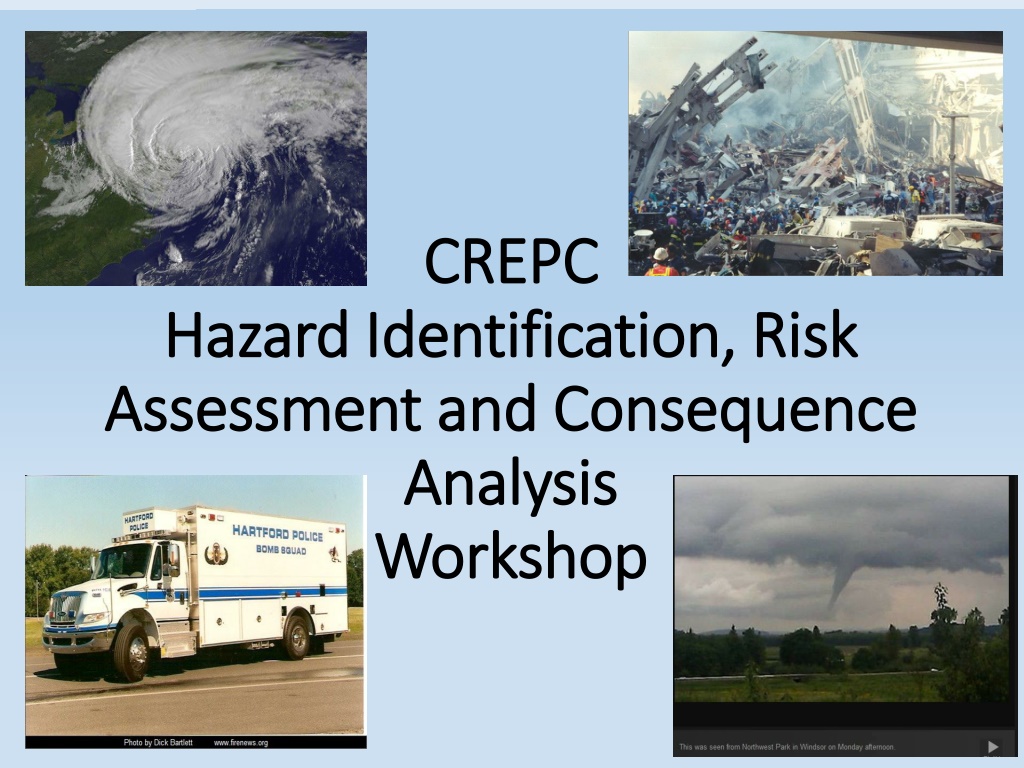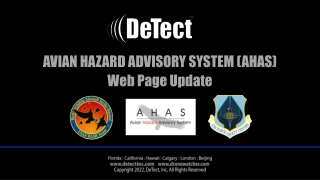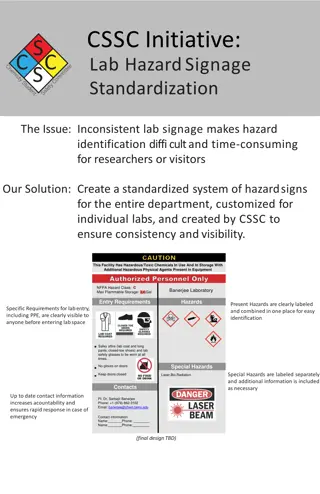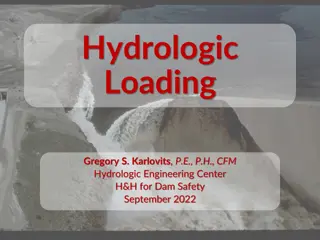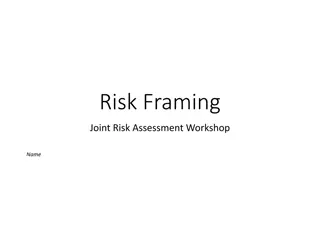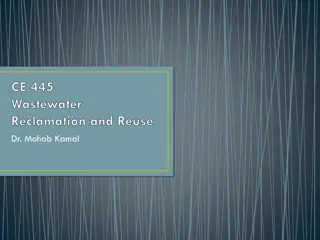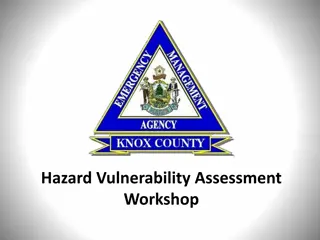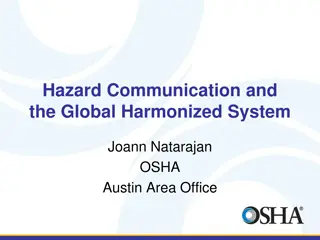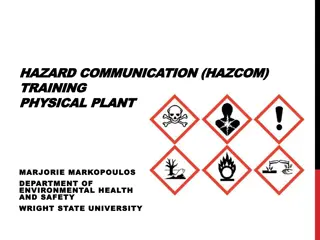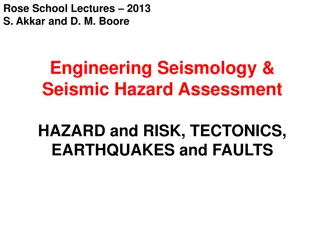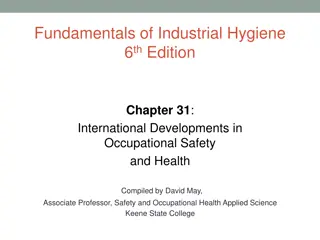Hazard Identification and Risk Assessment Workshop Overview
This workshop aims to identify natural and human-caused hazards impacting the Division of Emergency Management and Homeland Security Region 3. The process involves reviewing hazard identification tables, risk assessment, vulnerability assessment, and consolidating information from various documents. The discussions result in refining a list of potential hazards to determine their impact likelihood on the Capitol Region.
Download Presentation

Please find below an Image/Link to download the presentation.
The content on the website is provided AS IS for your information and personal use only. It may not be sold, licensed, or shared on other websites without obtaining consent from the author.If you encounter any issues during the download, it is possible that the publisher has removed the file from their server.
You are allowed to download the files provided on this website for personal or commercial use, subject to the condition that they are used lawfully. All files are the property of their respective owners.
The content on the website is provided AS IS for your information and personal use only. It may not be sold, licensed, or shared on other websites without obtaining consent from the author.
E N D
Presentation Transcript
CREPC CREPC Hazard Identification, Risk Hazard Identification, Risk Assessment and Consequence Assessment and Consequence Analysis Analysis Workshop Workshop
Purpose The purpose of this workshop is to identify the natural and human-caused hazards that potentially impact the Division of Emergency Management and Homeland Security Region 3 (DEMHS R-3). Also known as the Capitol Region
Overview Developmental Process Review of Development Tables Hazard Identification Tables 1.1 & 1.2.1 Risk Assessment Table 1.2.2 Hazard Vulnerability Assessment Table 1.3
Developmental Developmental Process Process The Emergency Management Accreditation Program (EMAP) Committee of CREPC researched and obtained the following documents in the development of this assessment and analysis. State of Connecticut Department of Emergency Services and public Protection/Division of Emergency Management and Homeland Security Connecticut s Hazard Identification Risk Assessment and Consequence Analysis, State of Connecticut Natural Hazard Mitigation Plan (2014) Capitol Region Natural Hazards Mitigation Plan (2014) The Department of Homeland Security (DHS) required Threat and Hazard Identification Risk Assessment (THIRA) (2012) The State of Connecticut Natural Disaster Plan (2009) Other Regional and Local Emergency Operation Plans for the Connecticut s DEMHS R-3 municipalities State of Connecticut Catastrophic Disaster Plan (2009) DEMHS Web Site Capitol Region Emergency Support Plan State of Connecticut Disaster Debris Management Plan (2013) Connecticut Climate Change Preparedness Plan (2011) State of Connecticut Dam Safety Program DHS 2013 Fusion Center Assessment Individual Report: Connecticut Intelligence Center.
Developmental Process The Committee then consolidated the hazards from these documents. As a result, three primary tables have been developed: Table 1.1 Identified hazards and potential for the hazard to occur using assigned rankings of likely , possible , and not likely Table 1.2.1Hazard Identification and Risk Assessment (HIRA) Table 1.3 Capitol Region Hazard and Vulnerability Assessment
Discussion: Identified hazards and potential for the hazard to occur A review of all the hazards listed in the documents above resulted in an initial list of over 50 possible hazards. This list was presented to the CREPC EMAP committee and through discussion this list was further refined and grouped into similar hazards and then determined to be considered likely, possible, or not likely to have an impact on the Capitol Region. Table 1.1 provides a listing of the 25 ranked hazards. Of the total, there were 19 that were ranked likely , six ranked possible. It should be noted that some planning documents have listed Lost/missing persons, mass evacuation incident, and space weather as possible hazards, however these are not included in the further analysis that was conducted for tables 1.2.2 and 1.3. For example Lost/missing persons and mass evacuation incident are considered a secondary action that may be tied to one or more of the hazards listed below. The term space weather refers to the variable conditions on the sun and in space that can influence the performance of technology used on Earth. Therefore for purposes of this hazard analysis space weather is included under cyber incident.
Table 1.1 Hazard Identification Identified Hazards (Natural & Human Caused) Cyber Incident Potential for Hazard (ranked) Likely May Include Rationale Hacking into public and private entities, includes the impacts of space weather on technology CT dams are defined by hazard class. The classification is as follows: C High Hazard (# of Dams 38); B Significant Hazard (59); the remaining 436 dams are moderate to no hazard. (BB to A classification) Real and constantly emerging threat. Dam Failure Possible Per State requirement emergency actions plans are required for high and significant hazard dams. As of July 2014 new regulations are being drafted by DEEP to implement this requirement. Per CT s and the Capitol Regions Hazard Mitigation Plan, Region-3 has a medium/low probability. . Per the Capitol Region Natural Hazards Mitigation (CR-NHMP) Plan there is a 14% chance of occurrence in any given year. Per CR-NHMP flooding is the most frequent natural hazard that impacts CT and the region. Drought Related Hazards Flood Related Hazards Meteorological, hydrological, agricultural, socioeconomic Likely Riverine flooding, flood, flash flooding, shallow flooding (urban flooding) Likely Food and Agricultural Disaster/Incident Biological or chemical agents, avian influenza, catastrophic animal mortalities, catastrophic vegetative waste Highway, rail freight incidents Likely Has occurred within the past decade, Natural disasters, barn collapse, tomato blight. Hazardous Materials Incidents/Accident (in transit) Industrial Incidents Likely Significant releases annually, captured databases DEEP, I-91 and I-84 are 2 of the major transportation corridors within the region (freight). CT and the Region has experienced a number of events dealing with hazardous materials being released to the environment and loss of life as a result of industrial incident. Local level event, region and state would support local efforts, this would also include silver and amber alerts within the region. Strong federal, state, and local partnerships addressing nuclear and radiological safety even though not in region a major incident would affect the Capitol Region. The grid is shown to be not reliable as a result of aging infrastructure; Potential impact of any of these events could be great, including but limited to loss or life, disruption of government, and adverse economic impacts to the public and private sectors Hazardous materials release Likely Lost / Missing Persons Large number of unaccounted people after a disaster Likely Fixed Nuclear Facility Incident Millstone Power Station (active); CT Yankee Station (decommissioned) Possible Power Failure Transit, impacts to homes, businesses and institutions Likely Significant Criminal Acts Terrorism incident, law enforcement and investigation incident, sabotage, school violence, conventional weapons, Weapons of Mass Destruction, Radiological release/dirty bomb, biological and chemical incidents, workplace violence Likely Special Events Road races, concerts, marathons, fireworks, festivals, UCONN football games Extreme cold, extreme hot Likely These events track large numbers of people and occur throughout the seasons. State of CT has initiated the Cold Weather Protocol numerous times, projected more 90 degree weather days. Per CR-NHMP, the Region has assigned a moderate risk probability to this type of event. In the Capitol Region, over the past 60 years there have been 36 tornados recorded, some resulting in loss of life and significant economic loss Temperature Extremes Likely Tornadoes Two types of tornadoes those that develop from super- cell thunderstorms and those that do not. Likely
Transportation Accidents Train derailment, highway incident, air incident, the transportation of radiological material Likely Past incidents include, Metro-North disruption, aging infrastructure, daily highway incidents, plane crashes. Hurricane/Tropical Cyclone Hurricanes, Tropical storms High winds, Severe thunderstorms Likely Per CR-NHMP, the region has assigned a high probability for this type of weather. A moderate to low probability of a major hurricane impacting the region. It is recognized that the major impacts would be the effects of flooding as a result of this type of hazard. State has prepared for widespread infectious disease. The region would assist the state in responding to an outbreak. Per CR-NHMP, the region has assigned a high probability for this type of event. Region 3 expects at least 2 or more winter significant weather events per winter season. The most recent storms have resulted in loss of life and significant economic loss Per CR-NHMP, the region has assigned a low probability for this type of event and high consequence for earthquake events. Widespread Infectious Disease Winter Related Hazards Virus/epidemic/ disease outbreak/ pandemic Likely Blizzard, freezing rain, ice storm, Nor Easter, sleet, snow, winter storm, ice jams Likely Earthquakes Region 3 may be categorized as having a low or moderate risk for an earthquake greater than or equal to 3.5 occurring in the future and a moderate risk of an earthquake less than or equal to 3.0 occurring in the future Low supply of propane, gasoline, electricity, heating oil Possible Energy/ Fuel Shortages Likely Result from a natural disaster or other disaster, less likely as a standalone event Per CR-NHMP, the region has assigned a moderate to low probability for this type of event. Many local communities that have significant wooded areas have or are in the process of developing management plans. The region experiences a number of smaller brush fires which will place this event in the likely category. State level (Unlikely), local or regional level (Likely) Wildland Fire Per the State s Natural Hazard Mitigation Plan a wildland fire is defined as any non-structure fire, other than prescribed fire that occurs in the wildland. In addition, a wildland-urban interface is defined as the line, area, or zone where structures and other human development meet or intermingle with undeveloped wildland or vegetative fuels. Evacuations could occur due to both natural and human- caused actions Impacts to public water supply and private wells as a result of natural disasters, accidents, and deliberate acts of vandalism or terrorism Protests, breach of peace, marches Likely Mass Evacuation Incident Water Contamination Possible Likely Per the State of CT, Department of Public Health s Emergency Response Planning Guide for Public Drinking Water Systems, March 2004 The State experiences numerous protests focused on single issues that arise and are addressed by increased police presence. Hartford the capitol of Connecticut is located in DEMHS R-3 and has numerous protests and marches. Per CT s Hazard Mitigation Plan landslides are referenced as a secondary hazard to a natural event Civil Disturbance Possible Landslide Unstable soils at construction sites, post-flood/storm erosion, and as a result of earthquakes Possible
Discussion: Hazard Identification and Discussion: Hazard Identification and Risk Assessment (HIRA Risk Assessment (HIRA) ) In addition to identifying natural and human-caused hazards, the CREPC Stakeholders and EMAP committee conducted a risk assessment to determine the potential impact of the hazards. A risk assessment is the process of measuring the potential loss of life, personal injury, economic injury, and property damage resulting from potential hazards. The focus of the risk assessment is to identify what natural and human caused hazards are present in the region and the potential impacts of those hazards and threats. Each hazard was evaluated individually and given a numerical value, as shown in the table below, to assess and quantify the hazard that may impact the region. The table provides definitions in their associated point value system that was created by the DEMHS staff during the States evaluation process. Table 1.2.1 shows the category, description, and point system that were used in creating Table 1.2.2.
Table 1.2.1 Category, description, and assigned values for hazard identification and risk assessment. DEMHS, March 2014 Assigned Values Category Frequency Description How often has the hazard occurred in the past One (1) Never occurred locally Two (2) Since historical record (400 years) Three (3) Once in past one hundred years Four (4) Once in past 50 years Five (5) Nearly every decade Geographic Extent Size of the affected area. Includes areas not damaged, but strongly affected by the incidents. For example, areas backed up by a transportation accident Single site. One or two towns. In one region In multiple regions Statewide Multi-State or national Duration How long does the acute crisis part of the disaster last Less than 24 hours 1-3 days 4-7 days 7-30 days 30+ days Environmental How damaging is the disaster for the natural environment No damage/temporary minor damage. Degradation of the ecosystem that will repair itself. Degradation of the ecosystem that requires intervention. Functional loss of ecosystem, but restoration possible. Permanent loss of ecosystem. Health Effects How dangerous is the hazard to human health and safety No deaths or injuries. 1-10 deaths and/or 1-100 injuries 11-50 deaths and/or 101-250 injuries. 51-250 deaths and or 250-1000 injuries. 251-1000 people displaced. 5%-30% of population experiencing acute shortages of supplies. Over 250 deaths and or 1000+ injuries. Displacement How likely is the hazard to negatively impact the exposed population in terms of displacement and personal property loss No displaced people/minor inconveniences Displaced people. Vulnerable population begins to have problems with access to essential supplies. Displaced people. Vulnerable populations have serious difficulties. General population starting to have problems. 1000+ people displaced. More than 30% of population facing acute shortages of basic supplies and access to services.
Economic Impacts How does the hazard affect the local economy No measurable impacts No impacts to overall economy, but isolated businesses experience hardships. Entire sectors experiencing loss of revenue and capital. Sectors of economic base affected & unable to generate revenue. Losses range between 1- 10% of assessed value. Physical losses equal to 10% of assessed value. Loss of ability to generate revenue. Built Environment How does the hazard affect buildings and physical infrastructure A: Property A: No effects A: 1 to 10 structures damaged A: 11 to 250 structures damaged A: 251 to 1000 structures damaged. Multiple utilities affected up to 25% - 50% loss B: Not applicable A: 1000+ structures damaged. At least two major utilities impacted by 50%+ loss. B: Infrastructure (water supply, wastewater, communications) B: No effects B: 1 to 5 public water supplies systems, 1-5 wastewater treatment facilities report failure. Communications C: Power Utilities B: 5 to 10 public water supplies systems B: Not applicable C: Power (energy) C: No effects C: Multiple utilities affected up to 25% loss One critical service inaccessible. Major state corridors open, but local streets impacted or impassible. C: Not applicable C: Not applicable Transportation How does the hazard affect the ability of residents and workers to access the resources they need? No effects on mobility All critical services accessible*, but delays reaching work or non-essential services. Many critical services inaccessible. One major state corridor inoperable. Most state corridors inaccessible. Most corridors impassible. *Critical services means critical life sustaining facilities, additional life sustaining facilities, critical community support facilities, critical infrastructure facilities, and
Critical Services (Includes COOP and Responders) How likely is the hazard to reduce the ability of government business to provide critical services? Little impairment on critical services Temporary degradation of 1 critical service Temporary degradation of multiple critical services. Long-term degradation of 1 critical service. Temporary degradation of most critical services. Long-term degradation of multiple critical services. Unable to deliver the most critical services. Confidence In Government Would public s confidence in government be shaken? No Not applicable Somewhat Not applicable Yes Cascading Effects How severe and complex will the secondary effects be? Hazard unlikely to cause secondary hazards, and if they occur are minor. Secondary hazards may occur, but are likely to be minor compared to the primary hazard Secondary hazards occur that extend the impact of the disaster and hamper response, but are not considered disasters. Secondary effects generated that significantly increase the magnitude of the disaster. Secondary impacts would be considered disasters if they occurred by themselves. Not applicable Secondary effects generated and rival or exceed primary hazard. Secondary impacts would be disasters if they occurred by themselves. Future Emphasis How much is the level of emphasis in mitigating, planning for, and preparing for this hazard changed based on trends, increasing understanding of the hazard, and changing underlying conditions that give rise to the hazard? Decreasing Emphasis Not applicable Emphasis Unchanged Increasing Emphasis
Table 1.2.2 Hazard Identification and Risk Assessment (HIRA) Category Relative Ranking (Risk) Multiplier(M) (F + CE) Cascading Effects (CE) Future Emphasis (FE) Geographic extent Built Environment Subtotal (BS*M) Critical Services Base Score (BS) Transportation Health Effects Displacement Confidence in Frequency (F) Econ Impacts Environment Identified Hazards government Duration Cyber Incident (H) Hurricane/Tropical cyclone (N) Winter Related Hazards (N) Widespread Infectious Disease (N/H) Flood Related Hazards (N) Significant Criminal Acts (H) Energy/ Fuel Shortages (N/H) *Nuclear Facility Incident (RERP) (H) Transportation Accidents (H) Food and Agricultural Disaster/Incident (N/H) Industrial Incidents (H) Dam Failure (N/H) Temperature Extremes (N) Power Failure (N/H) 5 5 5 5 5 4 4 5 2 5 5 2 3 5 3 3 3 5 2 5 4 4 3 1 3 3 1 5 3 3 5 3 3 4 2 3 2 4 2 2 5 4 3 4 3 2 2 5 2 1 5 3 2 3 2 2 3 5 2 2 5 3 3 1 3 2 3 4 2 3 5 4 3 2 3 3 3 2 4 1 5 3 3 4 2 2 3 2 3 1 5 3 3 5 3 5 3 5 3 3 4.9 3.4 3.1 3.4 2.9 2.9 2.7 4.2 2.5 2.6 5 5 5 5 5 5 5 1 5 5 5 4 4 3 4 4 3 4 3 2 10 9 9 8 9 9 8 5 8 7 49 30.6 27.9 27.2 26.1 26.1 21.6 21.0 20 18.2 5 5 5 5 5 5 5 5 5 5 54 35.6 32.9 32.2 31.1 31.1 26.6 26 25 23.2 1 1 4 3 2 2 4 3 3 3 2 1 2 3 2 2 2 4 3 3 2 2 2 2 2 3 2 2 3 2 2 2 2 2 2 2 3 3 1 3 2.2 2.5 2.4 2.3 5 4 5 5 3 3 2 2 8 7 7 7 17.6 17.5 16.8 16.1 3 3 3 3 20.6 20.5 19.8 19.1 Tornado (N) 2 2 3 2 3 2 2 2 2 1 2.2 5 2 7 15.4 3 18.4 Water Contamination (N/H) 2 3 3 2 1 2 2 1 1 3 2 5 2 7 14 3 17
Drought Related Hazards (N) Earthquake (N) Hazardous Materials Incidents/Accident (in transit) (H) Wildland fire (N/H) Civil Disturbance (H) Landslide (N) Special Events (H) 4 2 1 5 1 2 3 2 3 1 2 2 1 2 1 2 2 2 1 2 1 1 3 1 1 3 1 1 1 1 2 2 5 5 5 2 2 2 7 7 7 14 14 12.6 3 3 3 17 17 15.6 1.8 1 1 1 1 2 1 1 1 2 1 3 1 2 2 2 1 2 2 2 1 1 2 2 1 2 2 2 1 1 2 2 2 1 1 1 1 1 3 1 1 1.5 1.7 1.7 1.1 5 5 4 5 2 1 2 2 7 6 6 7 10.5 10.2 10.2 7.7 3 3 3 3 13.5 13.2 13.2 10.7 Key to Table 1.2.2 Greater than 30 Greater than 20 Greater than 10 Less than 10 (H) Human (N) Natural
Hazard Vulnerability Assessment Table 1.3
OVERALL HAZARD RATING MAGNITUDE/SEVERITY MITIGATION PROBABILITY HUMAN IMPACT PROPERTY IMPACT OPERATIONS IMPACT PREPARE- DNESS INTERNAL RESPONSE EXTERNAL RESPONSE Physical losses and damages (financial) Relative threat* Possibility of death or injury Time, Community/ Mutual Aid staff and supplies Likelihood this will occur Interruption of services Preplanning effectiveness, resources EVENT Cyber Incident 1 = Low 2 = Moderate 3 = High 1 = Low 2 = Moderate 3 = High 1 = Low 2 = Moderate 3 = High 1 = Low 2 = Moderate 3 = High 1 = High 2 = Moderate 3 = Low or none 1 = High 2 = Moderate 3 = Low or none 1 = High 2 = Moderate 3 = Low or none 0 - 100% 89% 3 2 3 3 3 3 2 Tornado 72% 3 3 3 2 2 2 1 Dam failure 67% 3 3 3 3 1 1 1 67% Tropical Cyclone 3 3 3 3 1 1 1 Flood Related hazards 67% 3 3 3 3 1 1 1 Significant Criminal Acts 67% 3 3 3 3 1 1 1 67% 67% 61% Winter Related Hazards Transportation Accidents Power failure Hazardous Materials Incidents/Accident (in transit) Industrial Incidents 3 3 3 3 3 2 3 3 2 3 3 3 1 1 1 1 1 1 1 1 2 56% 3 3 2 2 1 1 1 56% 3 3 2 2 1 1 1 Energy/Fuel Shortages 56% 3 1 1 2 2 2 2 44% Temperature Extremes Thunderstorm Related Hazards Special Events 3 3 1 1 1 1 1 39% 3 2 1 1 1 1 1 39% 3 2 1 1 1 1 1 Widespread Infectious Disease Food and Agricultural Disaster/Incident 37% 2 3 1 3 1 1 1 33% 2 2 2 2 1 1 1 33% 33% 22% 22% 20% Water Contamination Wildland Fire Earthquake 3 2 1 2 1 2 1 2 1 1 1 1 1 1 1 1 1 1 3 1 1 3 2 1 3 2 3 1 2 3 1 2 3 1 2 Nuclear Facility Incident Drought Related Hazards 19% Landslide 1 1 1 1 3 2 2
